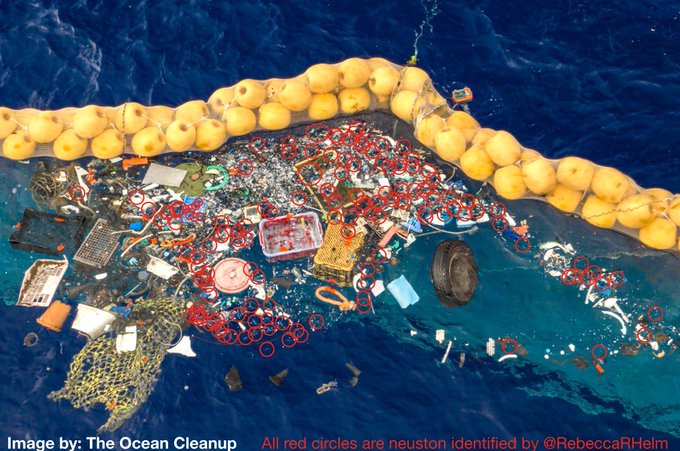Giant Machine is Cleaning Up the Huge Pacific Garbage Patch
In a historical first, a massive floating device designed by conservationists to clean up plastic from the ocean has successfully collected trash from the Great Pacific Garbage Patch.
The machine, which was invented by 25-year-old Dutch inventor and engineer Boyan Slat, consists of a huge line of cork floats holding a huge skirt that traps the garbage below.
On Wednesday, The Ocean Cleanup announced that the system was able to capture and hold trash ranging from visible plastic debris to large abandoned fishing gear known as “ghost nets”—and even tiny microplastics as small as 1 millimeter.

In the statement, Slat said:
“After beginning this journey seven years ago, this first year of testing in the unforgivable environment of the high seas strongly indicates that our vision is attainable and that the beginning of our mission to rid the ocean of plastic garbage, which has accumulated for decades, is within our sights.
Our team has remained steadfast in its determination to solve immense technical challenges to arrive at this point. Though we still have much more work to do, I am eternally grateful for the team’s commitment and dedication to the mission and look forward to continuing to the next phase of development.”
In case you missed it, here is a short recap of our announcement today. pic.twitter.com/bGhrkty5W6
— The Ocean Cleanup (@TheOceanCleanup) October 2, 2019
Launched from Vancouver in June, The Ocean Cleanup Project’s high-tech System 001/B is fitted with a variety of devices such as solar-powered lights, sensors, cameras, and satellite antennae that allow The Ocean Cleanup to keep tabs on it via GPS while also using a dedicated support vessel to collect the trapped plastic every few months before bringing it back to dry land.
System 001/B simulates a coastline and uses the ocean’s force to trap the countless pieces of plastic debris estimated to be swirling around in the patch.
Marine life is able to safely swim around the gigantic boom and, according to marine biologists who have tracked the system, no adverse environmental impact has resulted from the system’s deployment.
Slat said in a tweet that the system, along with its support vessel, is now in transit to port for a crew change and will resume collecting garbage on October 17.
Our vessel (with cleanup system) now in transit to port for crew change; expect to be back in the patch for final leg of the System 001/B campaign around Oct 17. pic.twitter.com/P9rmxU136w
— Boyan Slat (@BoyanSlat) October 3, 2019
Read more at www.wakingtimes.com
PRINCIPIA SCIENTIFIC INTERNATIONAL, legally registered in the UK as a company  incorporated for charitable purposes. Head Office: 27 Old Gloucester Street, London WC1N 3AX.
incorporated for charitable purposes. Head Office: 27 Old Gloucester Street, London WC1N 3AX.
Please DONATE TODAY To Help Our Non-Profit Mission To Defend The Scientific Method.
Trackback from your site.


T. C. Clark
| #
Where did it come from? What will be done with the material? It mostly originated in China and will China receive a cleanup bill?
Reply
Squidly
| #
Finally, someone actually doing something positive about our pollution and our environment. If you want to spend $billions on improving our environment, this is a much better place to start rather than the whole “cliiiimate change” hoax.
Reply
Charles Higley
| #
I have no problem with them cleaning up the plastic, but it’s sad that they think they are making a dent in the already natural destruction of plastic that is the reason they are now agonizing over micro plastics, which are evidence of the plastics breaking down.
Years ago, when idiot regulations lowered the fishing industry, they considered sending fishing boats out to mine the Garbage Patch. As there really is not huge patch of floating plastic, the fisherman would have been screwed.
Reply
Andy Rowlands
| #
Now this is reducing real actual pollution, for which I am all in favour.
Reply